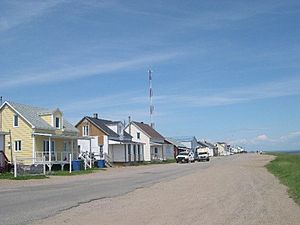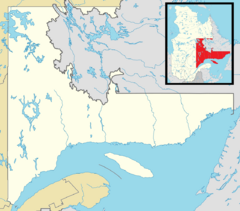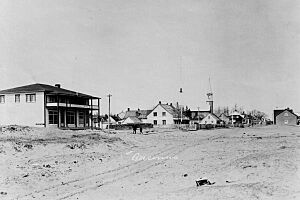Pessamit facts for kids
Quick facts for kids
Pessamit
|
|
|---|---|
|
Indian reserve
|
|
 |
|
| Country | Canada |
| Province | Quebec |
| Region | Côte-Nord |
| Regional county | None |
| Formed | 1861 (reserve) |
| Area | |
| • Land | 245.19 km2 (94.67 sq mi) |
| Population
(2021)
|
|
| • Total | 2,428 |
| • Density | 9.9/km2 (26/sq mi) |
| Time zone | UTC-5 (EST) |
| • Summer (DST) | UTC-4 (EDT) |
| Postal Code |
G0H 1B0
|
| Area code(s) | 418 and 581 |
Pessamit is a First Nations reserve and Innu community in Quebec, Canada. It used to be called Betsiamites or Bersimis.
Pessamit is located about 50 kilometers (31 miles) southwest of Baie-Comeau. It sits on the north shore of the Saint Lawrence River, right where the Betsiamites River flows into it. Across the river to the north is Rimouski, Quebec.
The community is home to the Pessamit Innu Band. The reserve includes two main areas: Betsiamites and Papinachois.
Contents
What's in a Name? The Meaning of Pessamit
The name Pessamit comes from the Innu language. Most experts agree it means "place where there are leeches or lampreys or sea eels." These are types of fish that live in water.
Older forms of the name, like "upesciyâmîhc," were used in other Innu dialects. Over time, the way people spoke in Pessamit changed. This led to the shorter, more modern pronunciation of Pessamit.
The names Betsiamites and Bersimis were also used for a long time. People like the Innu and missionaries often used Betsiamites. However, others, like explorers and trading companies, preferred Bersimis.
Even the local post offices had different names over the years. The post office on the west side of the Betsiamites River was called Bersimis, then Moulin-Bersimis, and later Rivière-Bersimis. On the east side, in the Innu village, it was Notre-Dame-de-Betshiamits, then Bersimis, and finally Betsiamites.
The reserve itself also changed names. It was first called Bersimis, then Betsiamites in 1981. Since 2008, it has been officially known as the Pessamit Indian Reserve.
A Look Back: The History of Pessamit
Indigenous people have lived in or visited the Pessamit area for many centuries. As early as the 1600s, explorer Samuel de Champlain noted an Innu village there. He called them Sauvages Bersiamiste on his map from 1632.
During the time when France controlled Canada, a trading post was set up near the Betsiamites River in 1733. This post was used for trading goods. Jesuit missionaries also came to the area to teach the Innu people about Christianity.
Later, the trading post was taken over by the North West Company. In 1821, this company joined with the Hudson's Bay Company (HBC). The HBC continued to run the trading post.
In 1845, records for the Notre-Dame-de-Betshiamits Mission began. A few years later, in 1849, the Innu people started clearing land to build a chapel. This was the beginning of the current village.
In 1853, the Innu of Betsiamites were given a large reserve of about 283 square kilometers (70,000 acres). This first reserve was located west of the Outardes River. In 1861, the Innu were allowed to move to the Bersimis Reserve, which was the same size.
For many years, the Innu families continued their traditional way of life. They were nomadic, meaning they moved around a lot. They spent most of their lives in the forest, hunting animals like caribou, beaver, and bear for food. They also hunted smaller animals like hare and partridge. They kept their traditional beliefs and skills.
From 1871 to 1902, the Bersimis trading post was very important for the Hudson's Bay Company. By 1900, a larger industrial town grew on the west side of the Betsiamites River. This town was called Bersimis (now Rivière-Bersimis).
In 1924, the local band council allowed the Government of Quebec to build a highway (Quebec Route 138) through the reserve. Later, in 1955, a road connecting the village to this highway was built.
The names of the band council and the reserve changed over time. On February 21, 1981, the Bersimis Band Council changed its name to Betsiamites. In 2005, it became the Innu Council of Pessamit. Finally, in 2008, the reserve's name was officially changed to Pessamit Indian Reserve.
People and Population
The population of Pessamit has changed over the years. Here's a quick look:
- In 1976, there were 1,686 people.
- By 2021, the population grew to 2,428 people.
Most people in Pessamit speak an Indigenous language as their first language.
- About 86.3% speak an Indigenous language.
- About 9.8% speak French.
- Very few speak English as their first language.
As of May 2024, there are 4,185 registered members of the Pessamit Innu Band.
- Many members live on the Betsiamites Reserve.
- Some live on other reserves.
- Others live off-reserve in different communities.
How Pessamit Makes a Living: Economy
The biggest employer in Pessamit is the band council, which manages the community. Another important employer is a forestry company called Société d'aménagement et de développement forestier de Betsiamites. This company manages logging activities in the forests on the reserve.
Economic growth in Pessamit is supported by the Société de développement économique de Betsiamites. Tourism is also important, managed by Développement touristique de Betsiamites. They run places like the Papinachois Resort and the Lac-des-Îles Outfitter, which offer outdoor activities.
Other ways Pessamit earns money include projects related to mining, wind power, and hydroelectricity (power from water).
Learning and Education
Pessamit has two schools for its young people:
- École Nussim: This school is for younger students, from pre-kindergarten up to elementary grade 6.
- École Uashkaikan: This school is for older students, covering secondary grades 1 to 5.



